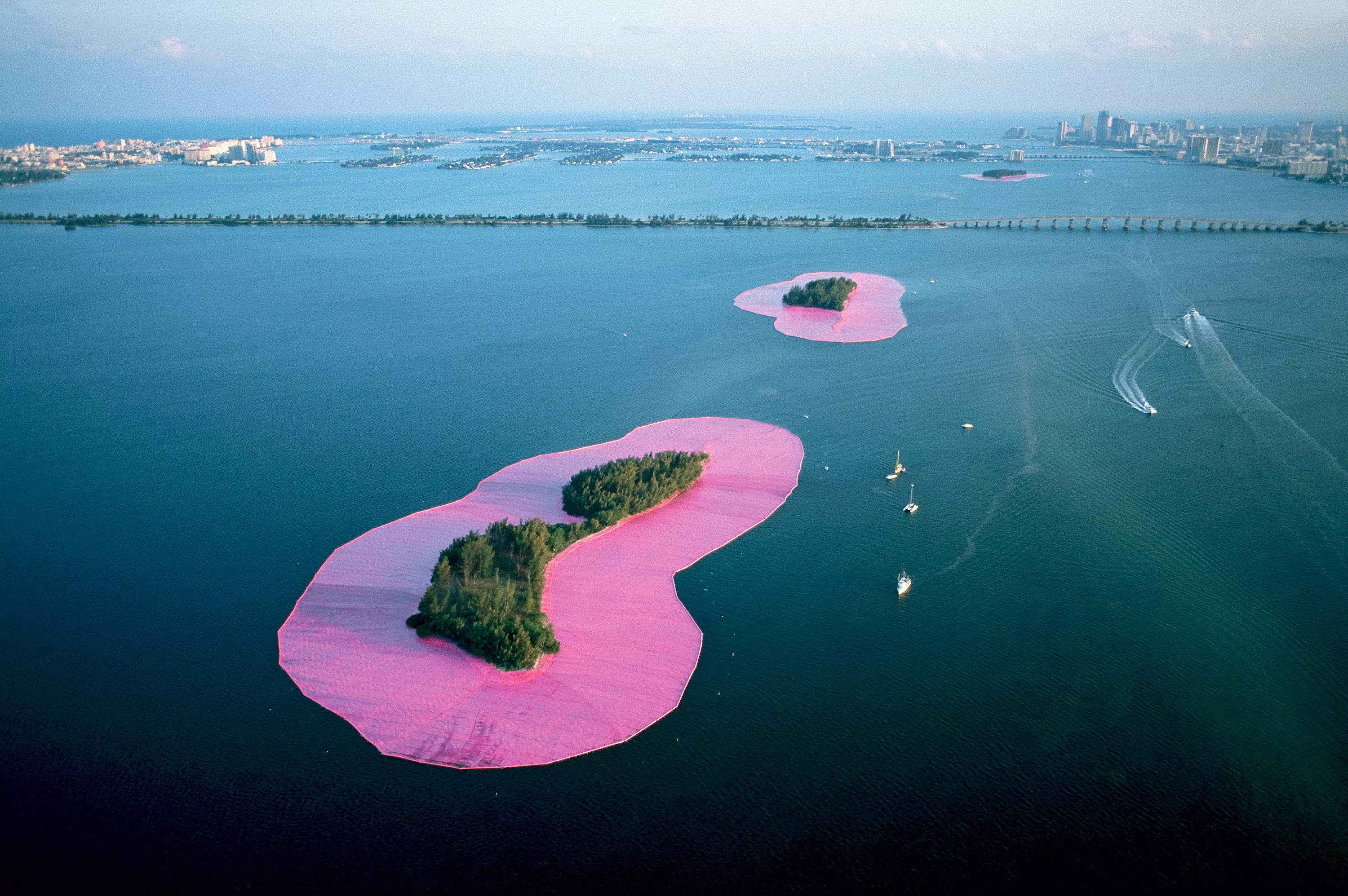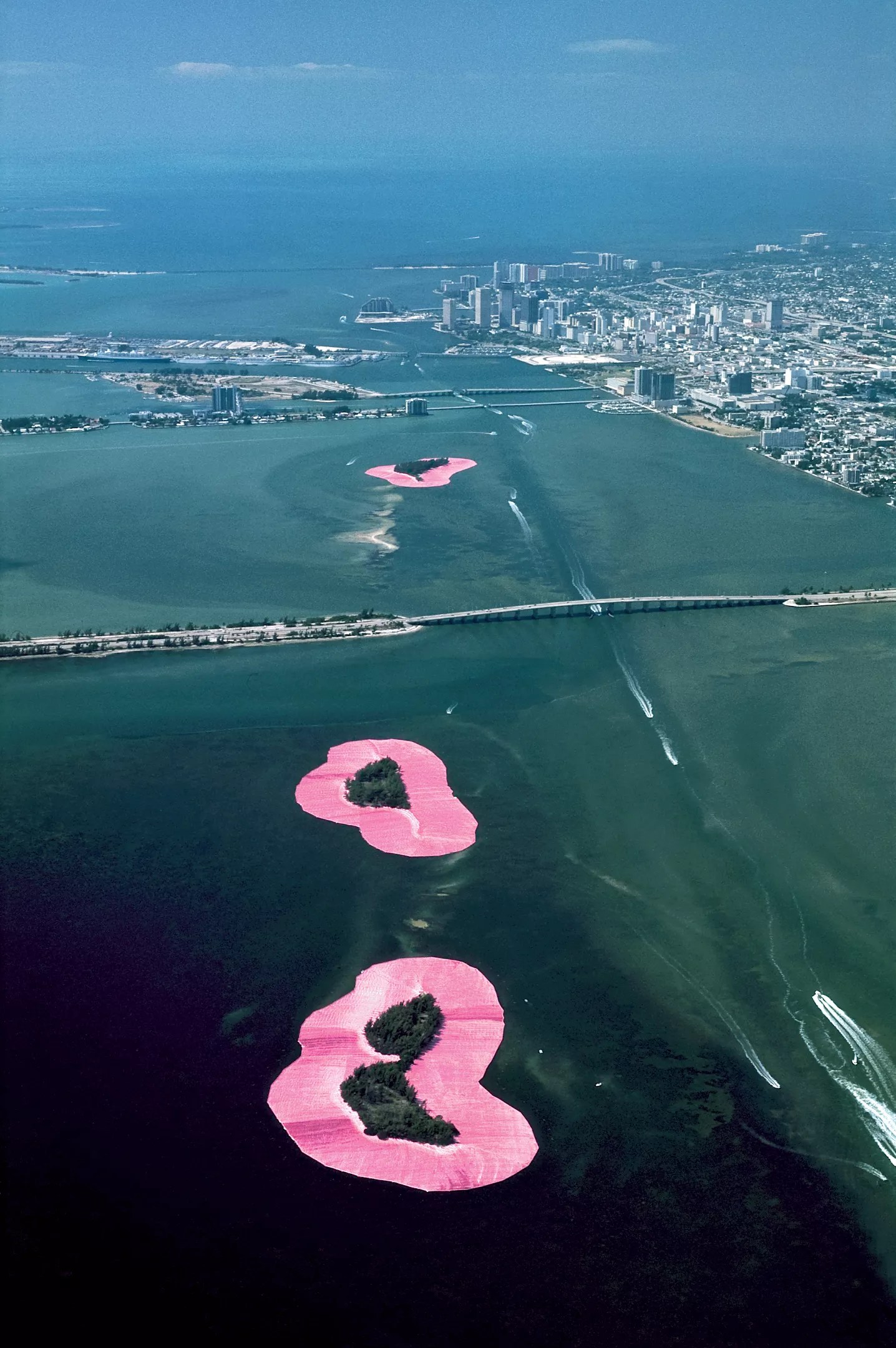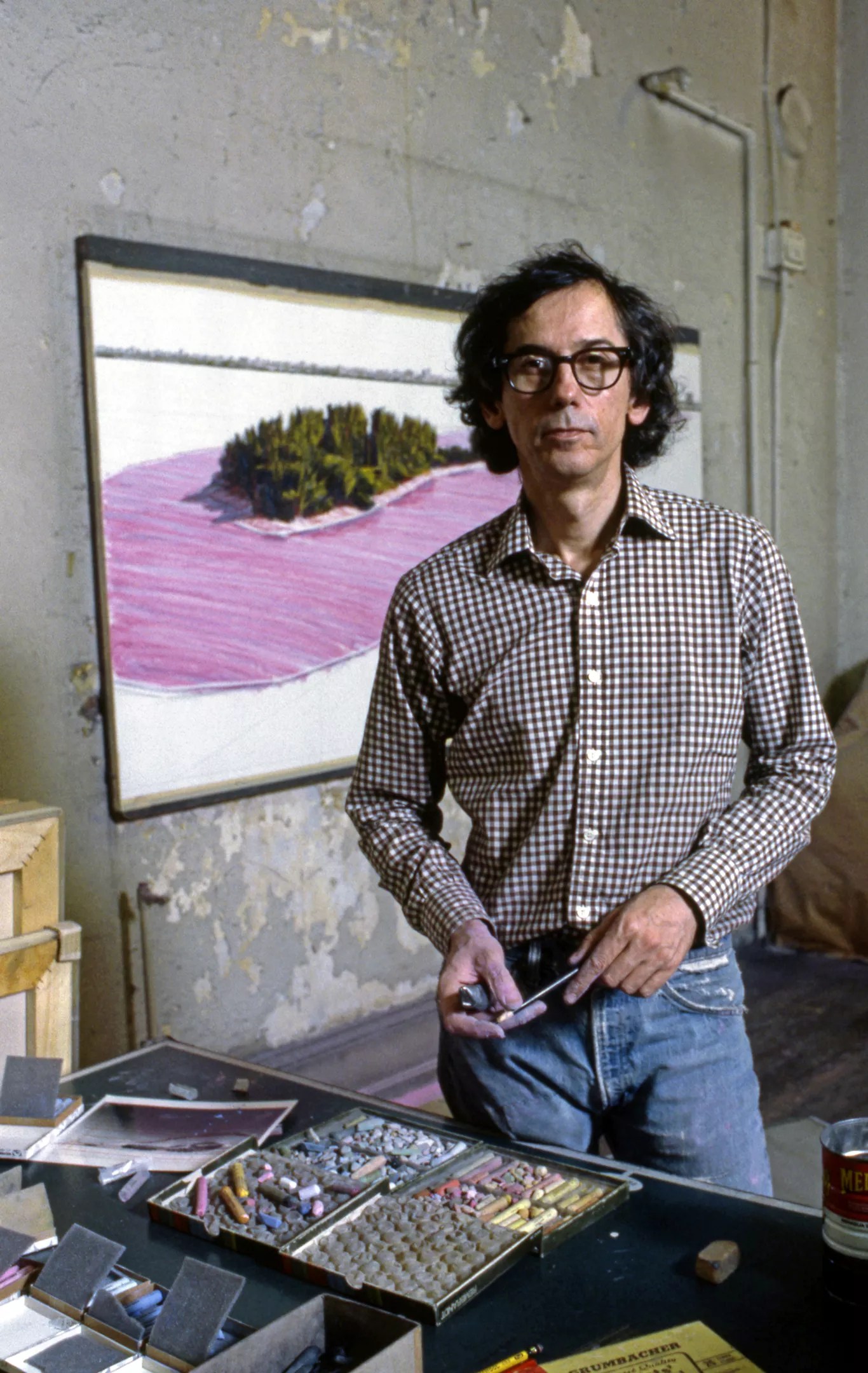
Photo by Wolfgang Volz

Audio By Carbonatix
In May 1983, Miami transcended all of its woes – the violent madness of the drug trade, the vehemence and unrest that followed the 1980 riots, the shame and degradation of being seen as a town in the throes of chaos – and was reborn in a vibrant pink that spread across Biscayne Bay. To this day, it remains a sight that almost defies belief: a string of islands hemmed in fabric that shone the very pinkest shade of pink. Shocking swaths of the hue sliced between sandy tree lines and the jade waters of the bay as if reality had slipped and the seams were bleeding pure color.
For the famed installation artist Christo and his wife and artistic partner, Jeanne-Claude, who passed away in 2009, Surrounded Islands is among their best-known American artworks. And for Miami, it stands as a watershed moment that gave the city new life.
Now, in celebration of the 35th anniversary of Surrounded Islands, Pérez Art Museum Miami will host an exhibition honoring and remembering the days when Christo and Jeanne-Claude transformed the bay, along with the years of work leading up to them. The exhibition – which will be on view Friday, October 5, through February 17 and include a lecture by Christo himself opening night – will include a number of drawings and plans for the endeavor, as well as other archival materials, ranging from legal documents to a documentary that captured the entire process of turning the idea into a reality. This will be the first time any of these pieces have been exhibited in the United States, and it seems only right it should happen in Miami.
This year, make your gift count –
Invest in local news that matters.
Our work is funded by readers like you who make voluntary gifts because they value our work and want to see it continue. Make a contribution today to help us reach our $30,000 goal!
“For my part,” says PAMM’s René Morales, who is curating the exhibition, “I remember more than anything the look of wonder on my father’s face and my sister’s face. I’ve always carried that with me, this idea that art can create this particular kind of wonder, that it can disrupt the normalcy of the everyday world and make us think about what might be possible beyond just the everyday. If nothing else, that’s what Christo and Jeanne-Claude’s work is all about.”

Surrounded Islands was a vast undertaking that stretched from Haulover Cut to the Venetian Causeway.
Photo by Wolfgang Volz
Surrounded Islands was a large-scale installation in Biscayne Bay. As its name implies, the project involved surrounding 11 islands in the bay between Haulover Park and the Venetian Causeway with pink polypropylene fabric. The material unfurled 200 feet from the shore of each island, totaling 6.5 million square feet of bright pink, all of which had to be specially made in Germany using massive, 15-foot-wide machines.
Christo and Jeanne-Claude’s inspiration came from the connection they saw among the people of Miami, the city itself, and the water that plays such an integral role of life in the Magic City. And for many Miamians, the way the project elevated that idea invigorated a deeper love for their city.
“They were inspired by that connection between the people and the water to highlight it and amplify it, and that’s exactly what the project did,” Morales notes. “It amplified it, it enhanced it, it magnified it. At the same time it celebrated that relationship, it also inspired more people to not take it for granted. Sometimes we can take for granted the things that we drive past every day, and so much of their work is about making us rethink the familiar.”

Many of Christo’s original renderings of the project, drawn atop aerial photographs of Biscayne Bay, will be on display.
Photo by Eeva-Inkeri
The now-iconic skirts were wrapped around the islands beginning May 4, 1983. They took three days to install and required the manpower of 430 workers. Over the next ten days, the city and the world, transfixed by what Christo and Jeanne-Claude had created, marveled at this marriage of nature and engineering and imagination that looked like a mirage or a fever dream in pink.
Though much of the public was aware of the project only for the two weeks in which it began and ended on the bay, the reality behind Christo and Jeanne-Claude’s endeavor is much larger than that. For them, it was a piece three years in the making – and in their eyes, that process was part of the artwork. They documented every individual’s experience and interaction with the creation of Surrounded Islands – from environmental scientists to politicians and legislators – because the artists genuinely believed the journey to reach the final product was as important as the final product itself.
For the generations born after the installation, for those of us who have only seen the aerial photos of those final days, PAMM’s exhibition offers a chance to step back into history and appreciate the project as a whole for the first time in three and a half decades. That opportunity is all the more significant when you consider it will be at PAMM, the direct descendant of the Center for the Fine Arts, which was founded by Jan van Der Marck, the man who invited Christo and Jeanne-Claude to bring their work to Miami, the same year Surrounded Islands came to fruition.

The exhibition includes photos documenting Christo and Jeanne-Claude’s journey to create Surrounded Islands.
Photo by Wolfgang Volz
“It’s significant because one of the very strong takeaways that I get from looking at all of this material is this very strong sense that it is possible for even an individual or a pair of individuals to go up against this huge machine that is the system, the establishment, and to change the world,” Morales says. “The whole narrative feels very empowering. If you dream a big enough dream, and if your vision is worthwhile, and if you have the willpower and the determination to do it, you can make really big things happen.”
Morales points out that that narrative, as significant and empowering as it may be for the individual, has likely been just as integral to the growth of the city over the years.
“Surrounded Islands marks this really pivotal moment in the history of our city. So much of our city goes back to the 1980s; certainly, the institutional history of this city really began right around the time of Surrounded Islands. And the same trajectory – the same sort of unified, long arc that you find from there to now in terms of the cultural life of this city – includes Art Basel, it includes the Wynwood arts scene, and it certainly includes the rise of the museums around our city,” Morales explains. “If you start to fast-forward to when people started to dream about things like Art Basel, things like Wynwood, things like these institutions that we now have and that we’re so lucky to have, in the back of their minds, I wonder to what extent this project served as inspiration.”
Surrounded Islands can be considered the beginning of a new era in Miami culture. After the pink, this city was different. It was suddenly a home for incredibly ambitious works of art. It was a place where locals found a renewed pride and joy in the often forgotten islands and in the water all around them. It was a place where the world could look and see more than bloodshed and depravity – they could see splendor and inspiration. It was a place on the rise. And it was beautiful.
“Christo and Jeanne-Claude: Surrounded Islands, Biscayne Bay, Greater Miami, Florida, 1980-83: A Documentary Exhibition.” Friday, October 5, through Sunday, February 17, at Pérez Art Museum Miami, 1103 Biscayne Blvd., Miami; 305-375-3000; pamm.org. Admission costs $16 for adults and $12 for students, seniors, and youth aged 7 to 18; museum members, active U.S. military, and kids aged 6 or younger get in free.